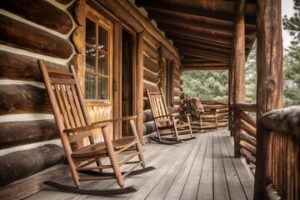Log homes present unique challenges that often fall outside the scope of traditional home inspections. To inspect them capably requires additional knowledge and a keen eye for details that are not easily visible.
For example, check the condition of chinking and caulk to see if it is doing its job. Look for checks, cracks, and discoloration that could indicate water infiltration. Also, examine the roof to see if it adequately overhangs log walls. Contact Richardson Log Homes LLC experts today to inspect your log home.

Check The Roof
Log home professionals typically recommend that a homeowner inspect the roof and the areas around the roof during a regular inspection. These areas are prone to moisture intrusion and are often overlooked by homeowners. This can lead to wood rot, mold, and insect infestation. Look for moss, fungus, and lichen growing on the roof. These organisms thrive in moist conditions and are a sign of problems in the surrounding logs. In addition, the presence of these organisms suggests that the home may not be properly chinked and sealed.
A log home’s roof should be inspected for the following problems:
Check the condition of the flashing and gutter systems. Check that there are no huge gaps between the log wall and the roof deck. Look for chinking and caulking that is missing, discolored, or damaged. Inspect the condition of the logs at the ends of the roof, and those that stick out through the roof overhang. These areas tend to absorb more water than the rest of the logs and are vulnerable to rot and insect infestation.
Look for evidence of wood-destroying insects such as termites and carpenter ants. Pay special attention to wing piles, which are a sure sign that termites have been present. Check for a proper and effective wood preservative system in these areas, including the use of borates or impenetrable rods.
Also, be sure to examine the interior of the log walls for signs of decay. This is particularly important in log extensions and corner areas, which are less protected by the roof overhang. This is also a common area for moisture to penetrate the logs, resulting in rot and decay, which can then spread to the foundation and other structural members of the home.
Check for the presence of insect holes in and around windows and doors. Most log homes settle over time, and this can cause door frames and windows to no longer fit properly. Check for air and water leaks in these areas as well as at any places where the logs meet other materials such as the floor assembly, the foundation, or the deck.
Check The Exterior
Log homes differ from conventional stick-built houses in many ways that require special expertise and a different set of skills to inspect properly. For home inspectors, this provides a highly marketable niche service.
Settling of log walls is one major concern that requires a specialized inspection. This entails checking the condition of log corners, windows, doorways, and eaves, and looking for gaps that may be due to the movement of the logs.
Another common problem is the occurrence of wood rot within the logs themselves. Inspecting the logs for signs of rot can include using a screwdriver to probe them, and looking for any indication of wormholes (these are usually accompanied by a pile of sawdust). The presence of carpenter bees or ants is also an indicator of possible wood rot, as they burrow honeycombed tunnels in soft decaying wood.
Moisture control is another important issue to look for in a log home. Logs naturally seek to absorb moisture, so they need to be well-ventilated. Also, they should be protected from water intrusion by proper chinking and stormwater control.
During a log home inspection, your professional home inspector will also check for any evidence of exterior finish problems that might have developed over time. A good way to test the quality of a finish is to spray it with water and see if it beads up or soaks into the wood. Absorption indicates a poor-quality finish and should be reapplied.
Also, a home inspector should determine how well the roof overhangs protect the logs from rain and wind. For instance, older homes often had shallow overhangs that did not provide adequate protection. As a result, the lower courses of logs are constantly dripped on and exposed to other weather elements that can cause rot.
Other areas of concern for a log home inspector to look at include the condition of collar ties (which help keep the upper two-thirds of log walls in place), and the condition of the top course of logs. If the top logs are not cut to a consistent length, or if they do not have a continuous weather strip around them, they can lose height over time, resulting in a loss of structural integrity.
Check The Interior
Log homes require a different approach to inspection and a special skill set that not every home inspector is qualified to provide. Whether you’re an existing home inspector who wants to branch out into log homes or you’re looking for a way to add value to your service, the training offered by the institute will give you the tools you need to thoroughly inspect these unique structures.
The most common problems in log homes are settling and wood rot. During the inspection, your eye should be on everything that touches or connects to the logs to ensure they are in good condition. Checking doors and windows for a proper fit is important, especially in older homes. In these cases, the original installers often did not leave enough space to prevent the walls from pushing out the door or window. In addition, if the logs are not treated properly with chinking and caulking after installation moisture can leak in and lead to the need for rot treatment or replacement.
Checking for insect infestation is also essential. Look for piles of sawdust that can indicate carpenter ants or bees are burrowing through the logs. A little bit of this activity is normal but more can indicate a problem. Check the stair logs to ensure they are not bowing or sticking as well. Stairs are often the first thing to show signs of rot because they’re exposed to the elements much more than the other logs in the house.
During the inspection, you should also check for sagging or uneven rooflines that expose the lower courses of logs to back-splash. The lower course of logs is the most likely to rot because they are constantly exposed to water that may seep through the roof or cracks in the flashing.
The most difficult area of the log wall to inspect is the top third of the structure. Collar ties, which are the vertical pieces of wood that hold the upper and lower wall sections together, can be very weak in older homes because they are often cut too short. Checking these areas for signs of rot is vital to ensure the stability of the walls.
Check The Structural Integrity
Log homes have unique characteristics that differ from conventional houses, and a home inspector with experience in inspecting them will recognize problems that may not be evident to the uninitiated. Drastic errors have cost many log homeowners thousands of dollars, and they can often be avoided by a thorough inspection conducted by someone with specialized knowledge of the type of structure.
Look for signs of wood rot, both visible and hidden. The wood in log walls will absorb and retain moisture differently than wood in conventional stud-built structures, which can lead to rot and other structural issues. In addition, rot can cause mold, mildew, and insect infestations. Look at the tops of all exterior logs, the corners, stairway railings, porch supports, and other areas that are most likely to harbor moisture. Check the roof to make sure it adequately overhangs the logs to prevent moisture from collecting in these areas.
Be on the alert for lengthwise cracks in logs. These can be a result of shrinkage during drying or simply a natural process called “checking.” Check the condition of the filler material that is used to cover gaps between the logs, known as chinking. In most cases, this will need to be reapplied or replaced periodically.
Also look for a lack of thinking in the dormers and upper-story windows, as these are places where moisture is more likely to collect. Finally, if the logs are painted instead of stained, look for signs of deterioration and wear, which will probably need to be recoated or re-stained.
Staining is important for the long-term health of a log home, as it helps protect the wood from damage caused by the sun’s UV rays and water. Different stains and coatings are available, and your home inspector can help you determine which will best protect the logs and fit the aesthetic of the house. Test the stain by spraying some water on a few of the logs. If the water beads, the stain is still working well; if it soaks in and begins to discolor the logs, it’s time for a new coat.

